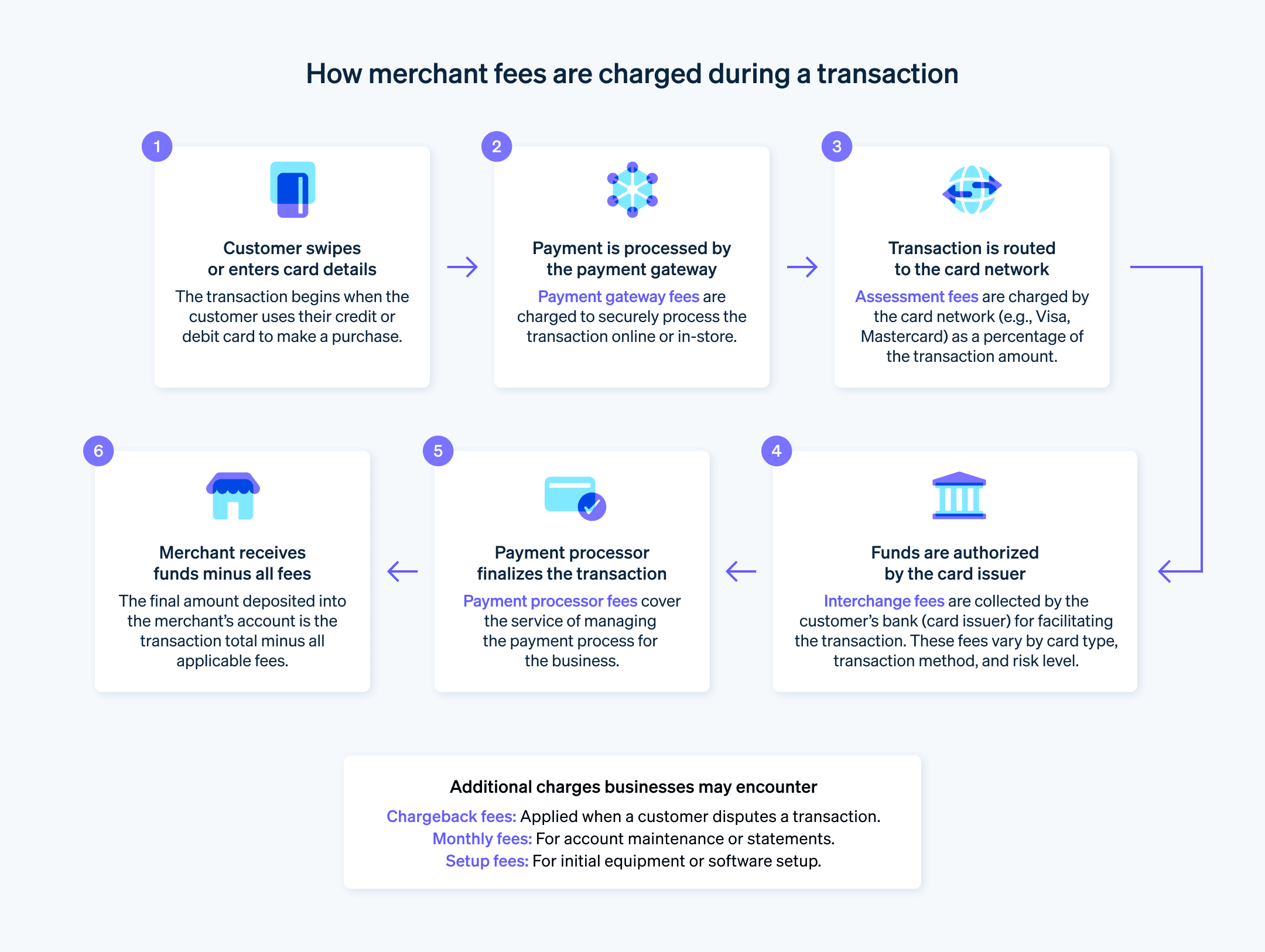ค่าธรรมเนียมผู้ค้าคือค่าใช้จ่ายเรียกเก็บที่ธุรกิจต้องจ่ายเมื่อรับชำระเงินทางอิเล็กทรอนิกส์ เช่น บัตรเครดิตหรือบัตรเดบิต ค่าธรรมเนียมเหล่านี้ประกอบด้วยค่าใช้จ่ายหลายอย่างรวมกัน และมักคิดเป็นเป็นเปอร์เซ็นต์จากยอดธุรกรรม ซึ่งบางครั้งมีค่าธรรมเนียมคงที่เพิ่มเติม แม้ว่าค่าธรรมเนียมผู้ค้าจะเป็นเพียงส่วนหนึ่งของราคาธุรกรรมทั้งหมด แต่ก็เป็นค่าใช้จ่ายที่ไม่น้อย จากรายงานของ Nilson ธุรกิจในสหรัฐอเมริกาจ่ายค่าธรรมเนียมรวมทั้งหมด 160.7 พันล้านดอลลาร์สหรัฐเพื่อดำเนินรายการชําระเงินเกือบ 10.6 ล้านล้านดอลลาร์สหรัฐในปี 2022
ด้านล่างนี้จะอธิบายถึงองค์ประกอบหลักของค่าธรรมเนียมผู้ค้า รวมถึงประเภทของค่าธรรมเนียมที่ธุรกิจส่วนใหญ่จะต้องพบ วิธีการดำเนินการเพื่อลดผลกระทบทางการเงินโดยรวมจากค่าธรรมเนียมผู้ค้าที่มีต่อผลกําไรของคุณ การรวมถึงปัจจัยที่ควรพิจารณาเมื่อเลือกผู้ให้บริการประมวลผลการชําระเงิน
บทความนี้ให้ข้อมูลอะไรบ้าง
- ประเภทของค่าธรรมเนียมผู้ค้า
- เหตุใดค่าธรรมเนียมผู้ค้าจึงเป็นเรื่องสำคัญที่ธุรกิจควรทำความเข้าใจเป็นอย่างยิ่ง
- วิธีลดค่าธรรมเนียมและค่าใช้จ่ายของผู้ค้า
- วิธีเลือกผู้ให้บริการประมวลผลการชําระเงิน
- ค่าธรรมเนียมผู้ค้าของ Stripe
ประเภทของค่าธรรมเนียมผู้ค้า
ค่าธรรมเนียมผู้ค้าครอบคลุมค่าใช้จ่ายเรียกเก็บหลายอย่างที่ธุรกิจต้องพบเมื่อมีการประมวลผลการชําระเงินทางอิเล็กทรอนิกส์ เช่น ธุรกรรมบัตรเครดิตหรือบัตรเดบิต ค่าธรรมเนียมผู้ค้าประเภทหลักๆ ได้แก่
ค่าธรรมเนียมธุรกรรมผ่านบัตรระหว่างธนาคาร: รายการเหล่านี้คือค่าธรรมเนียมที่ธนาคารผู้ออกบัตรเครดิตหรือบัตรเดบิตของลูกค้าเรียกเก็บ ยอดเงินคิดเป็นเปอร์เซ็นต์ของมูลค่าธุรกรรมและอาจรวมค่าธรรมเนียมคงที่ อัตราค่าธรรมเนียมธุรกรรมผ่านบัตรระหว่างธนาคาร จะแตกต่างกันไปตามปัจจัยต่างๆ เช่น ประเภทของบัตรที่ใช้ ระดับความเสี่ยงของธุรกรรม และขึ้นอยู่กับว่าธุรกรรมดําเนินการที่จุดขายหรือออนไลน์
ค่าธรรมเนียมเครือข่ายระบบชำระเงิน: ค่าธรรมเนียมเหล่านี้ซึ่งเรียกเก็บโดยเครือข่ายบัตรเครดิต (เช่น Visa Mastercard American Express ฯลฯ) โดยปกติแล้วจะเป็นเปอร์เซ็นต์คงที่ของยอดธุรกรรม ธนาคารของผู้ประกอบธุรกิจจ่ายค่าธรรมเนียมเครือข่ายระบบชำระเงินให้กับเครือข่ายบัตร
ค่าธรรมเนียมผู้ประมวลผลการชําระเงิน: ค่าธรรมเนียมเหล่านี้เรียกเก็บโดยบริษัทผู้ประมวลผลการชําระเงิน ซึ่งจัดการการประมวลผลธุรกรรมในนามของธุรกิจ โดยสามารถวางโครงสร้างได้หลายวิธี ซึ่งรวมถึงการคิดเป็นเปอร์เซ็นต์จากธุรกรรมแต่ละรายการ ค่าธรรมเนียมคงที่ต่อรายการ ค่าธรรมเนียมรายเดือน หรือทุกอย่างรวมกัน
ค่าธรรมเนียมรายการเดินบัญชีรายเดือน: ผู้ประมวลผลการชําระเงินบางรายมีการเรียกเก็บค่าธรรมเนียมรายการเดินบัญชีรายเดือน
ค่าธรรมเนียมเกตเวย์การชําระเงิน: ธุรกิจต่างๆ มักจะใช้เกตเวย์การชําระเงิน สําหรับธุรกรรมออนไลน์ และบริการนี้อาจมาพร้อมกับชุดค่าธรรมเนียมของตัวเอง ซึ่งอาจเป็นค่าธรรมเนียมต่อรายการ ค่าธรรมเนียมรายเดือน หรือทั้งสองอย่าง
ค่าธรรมเนียมรายเดือนขั้นต่ำ: ผู้ประมวลผลบางรายเรียกเก็บค่าธรรมเนียมรายเดือนขั้นต่ำ ซึ่งเป็นจํานวนต่ำสุดที่ธุรกิจต้องจ่ายเป็นค่าธรรมเนียมการประมวลผลต่อเดือน หากค่าธรรมเนียมจากธุรกรรมไม่ถึงจํานวนดังกล่าว ธุรกิจจะต้องจ่ายส่วนต่างนี้
ค่าธรรมเนียมติดตั้งและอุปกรณ์: ค่าธรรมเนียมเหล่านี้ครอบคลุมการตั้งค่าบัญชีผู้ค้า หรือการเช่าหรือซื้อฮาร์ดแวร์ที่จําเป็น (เช่น ระบบ POS หรือเครื่องอ่านบัตร)
ค่าธรรมเนียมการดึงเงินคืน: เมื่อลูกค้าโต้แย้งรายการธุรกรรม อาจส่งผลให้ธุรกิจต้องคืนเงิน ซึ่งเรียกว่าการดึงเงินคืน เมื่อเกิดการดึงเงินคืน ธุรกิจมักจะถูกเรียกเก็บค่าธรรมเนียม โดยค่าธรรมเนียมนี้จะครอบคลุมค่าใช้จ่ายในการจัดการการโต้แย้งการชำระเงิน
ค่าธรรมเนียมการยกเลิกข้อตกลงก่อนเวลา: ข้อตกลงการให้บริการของผู้ค้าบางรายการมีระยะเวลาของสัญญา และการยุติสัญญาก่อนกําหนดอาจทําให้เกิดค่าธรรมเนียมได้
ค่าธรรมเนียมตามกรณี: ค่าธรรมเนียมเหล่านี้อาจรวมค่าธรรมเนียมสําหรับบริการเพิ่มเติม เช่น รายการเดินบัญชีแบบกระดาษ ค่าธรรมเนียมการประมวลผลแบบเป็นชุด หรือค่าธรรมเนียมการไม่ปฏิบัติตามมาตรฐานความปลอดภัย
เหตุใดค่าธรรมเนียมผู้ค้าจึงเป็นเรื่องสำคัญที่ธุรกิจควรทำความเข้าใจเป็นอย่างยิ่ง
ค่าธรรมเนียมผู้ค้าส่งผลกระทบโดยตรงต่อความสามารถในการทํากําไรของธุรกิจ ค่าใช้จ่ายที่มาพร้อมกับการรูดบัตรเครดิตหรือบัตรเดบิตทุกครั้งอาจกินกําไรธุรกิจได้หากไม่ได้รับการจัดการอย่างถูกต้อง
ด้วยเหตุนี้การทําความเข้าใจค่าธรรมเนียมผู้ค้าจึงมีความสําคัญอย่างยิ่ง
มีผลต่อค่าบริการ ค่าธรรมเนียมผู้ค้าเป็นค่าใช้จ่ายทางธุรกิจ เช่นเดียวกับค่าเช่าหรือเงินเดือนพนักงาน เพื่อจัดการค่าใช้จ่ายเหล่านี้ ธุรกิจจำเป็นต้องรับค่าใช้จ่ายเหล่านี้โดยใช้ผลกําไรหรือส่งต่อให้ลูกค้าในรูปแบบของราคาที่สูงขึ้น การทําความเข้าใจค่าธรรมเนียมผู้ค้าจะเป็นข้อมูลในการตัดสินใจเกี่ยวกับการทำกลยุทธ์ด้านราคาและป้องกันการเสียเงินไปกับรายการธุรกรรม
อาจแตกต่างกันอย่างมาก: บัตร ยอดธุรกรรม และธุรกิจประเภทต่างๆ มีค่าธรรมเนียมธุรกรรมผ่านบัตรระหว่างธนาคารที่แตกต่างกัน ตัวอย่างเช่น โดยทั่วไปบัตรเดบิตจะมีค่าธรรมเนียมธุรกรรมผ่านบัตรระหว่างธนาคารต่ํากว่าบัตรเครดิต และธุรกรรมออนไลน์ มักมีค่าธรรมเนียมสูงกว่าการซื้อในร้าน การเรียนรู้ความแตกต่างเหล่านี้ช่วยให้คุณเลือกวิธีการชําระเงินและตัวเลือกการประมวลผลที่คุ้มค่าที่สุดสําหรับธุรกิจของคุณได้
สามารถต่อรองได้: แม้เครือข่ายบัตรจะเป็นผู้กําหนดค่าธรรมเนียมบางประการ เช่น ค่าธรรมเนียมธุรกรรมผ่านบัตรระหว่างธนาคาร แต่ค่าธรรมเนียมอื่นๆ เช่น ค่าธรรมเนียมบัญชีผู้ค้า คุณสามารถต่อรองกับผู้ประมวลผลการชําระเงินของคุณได้ การเข้าใจเรื่องค่าธรรมเนียมประเภทต่างๆ และวิธีการคํานวณค่าธรรมเนียมช่วยให้คุณมีอำนาจต่อรองอัตราค่าธรรมเนียมที่ดีกว่าได้
ช่วยคุณระบุการฉ้อโกงได้: ค่าธรรมเนียมผู้ค้าบางอย่าง เช่น ค่าธรรมเนียมการดึงเงินคืน จะเกิดขึ้นเมื่อลูกค้าโต้แย้งธุรกรรม การเรียนรู้เกี่ยวกับค่าธรรมเนียมที่เกี่ยวข้องกับการดึงเงินคืนจะช่วยเตรียมความพร้อมให้คุณจัดการกับการฉ้อโกง และป้องกันไม่ให้เกิดผลกระทบกับกําไรของคุณ

วิธีลดค่าธรรมเนียมและค่าใช้จ่ายของผู้ค้า
แม้ค่าธรรมเนียมผู้ค้าจะเป็นส่วนที่หลีกเลี่ยงไม่ได้ในการประมวลผลการชําระเงินสําหรับธุรกิจสมัยใหม่ แต่กลยุทธ์ที่เหมาะสมก็สามารถลดค่าใช้จ่ายและลดความยุ่งยากได้ ต่อไปนี้คือตัวอย่างวิธีการหลักๆ ที่สามารถทําได้:
เลือกผู้ประมวลผลการชําระเงินที่เหมาะสม: การเลือกผู้ประมวลผลการชําระเงินที่เหมาะสมหมายถึงการประเมินโครงสร้างค่าธรรมเนียมเทียบกับรูปแบบธุรกรรมของธุรกิจคุณ ผู้ประมวลผลมีข้อกําหนดที่แตกต่างกันสําหรับขนาดและปริมาณธุรกรรมที่แตกต่างกัน และบางรายอาจให้สิทธิประโยชน์เฉพาะสําหรับอุตสาหกรรมของคุณ
เจรจาขออัตราค่าบริการที่ต่ำลง: ธุรกิจที่มีปริมาณธุรกรรมสูงหรือมีประวัติการขายที่มั่นคงมีแนวโน้มที่จะต่อรองขออัตราค่าธรรมเนียมที่ลดลงกับผู้ประมวลผลการชําระเงินได้
สนับสนุนการชําระเงินด้วยบัตรเดบิต: โดยปกติแล้วธุรกรรมผ่านบัตรเดบิตจะมีค่าธรรมเนียมต่ํากว่าบัตรเครดิต การส่งเสริมให้ลูกค้าใช้บัตรเดบิตโดยอาจเสนอสิ่งจูงใจหรือส่วนลด สามารถช่วยลดค่าใช้จ่ายด้านธุรกรรมโดยรวมได้
ใช้บริการยืนยันที่อยู่ (AVS): AVS ช่วยลดความเสี่ยงจากการฉ้อโกงในธุรกรรมออนไลน์ ซึ่งอาจนำไปสู่ค่าธรรมเนียมธุรกรรมที่ลดลงและลดการดึงเงินคืนลงได้
กําหนดยอดธุรกรรมบัตรขั้นต่ำ: การนําข้อกําหนดการซื้อขั้นต่ำมาใช้กับการชําระเงินด้วยบัตรสามารถช่วยชดเชยค่าธรรมเนียมธุรกรรม ทําให้ธุรกรรมขนาดเล็กมีต้นทุนต่ำลงและช่วยปกป้องผลกําไรได้
ประมวลผลธุรกรรมแบบเป็นชุด: การประมวลผลธุรกรรมผ่านบัตรทั้งหมดเป็นชุดเดียว ซึ่งโดยปกติจะทำตอนสิ้นวัน คุ้มค่ากว่าการประมวลผลธุรกรรมแต่ละรายการตอนที่เกิดธุรกรรม
เลือกฮาร์ดแวร์และซอฟต์แวร์ที่ได้มาตรฐาน: การใช้โซลูชันการประมวลผลการชําระเงินที่มีการรองรับอย่างกว้างขวางและเป็นมาตรฐานช่วยให้ธุรกิจประหยัดมากขึ้นได้ การใช้โซลูชันประเภทนี้ยังช่วยให้ธุรกิจเข้าถึงการสนับสนุนและการบํารุงรักษาได้ง่ายขึ้นอีกด้วย
หลีกเลี่ยงการดึงเงินคืน: ธุรกิจสามารถลดการดึงเงินคืนด้วยนโยบายที่ชัดเจน การบริการลูกค้าที่ยอดเยี่ยม และมาตรการการป้องกันการฉ้อโกง ที่ครอบคลุม การดึงเงินคืนมีค่าธรรมเนียมเพิ่มเติมและทำให้ค่าใช้จ่ายในการประมวลผลการชําระเงินของธุรกิจเพิ่มขึ้นได้
ตรวจสอบรายการเดินบัญชีผู้ค้าของคุณเป็นประจํา: การตรวจสอบรายการเดินบัญชีจะช่วยคุณระบุและจัดการกับค่าธรรมเนียมที่ไม่คาดคิด ข้อผิดพลาดในการเรียกเก็บเงิน หรือการเปลี่ยนแปลงโครงสร้างค่าธรรมเนียมได้
ตรวจสอบการปฏิบัติตามข้อกําหนดของ PCI: การปฏิบัติตามข้อกำหนดของมาตรฐานการรักษาความปลอดภัยข้อมูลสําหรับอุตสาหกรรมบัตรชําระเงิน (PCI DSS) ช่วยให้คุณหลีกเลี่ยงค่าธรรมเนียมจากการไม่ปฏิบัติตามข้อกําหนดและป้องกันการละเมิดข้อมูลที่มีค่าความเสียหายสูงและค่าปรับที่เกี่ยวข้อง
ประมวลผลนอกช่วงเวลาที่มีการใช้งานสูง: ผู้ประมวลผลการชําระเงินบางรายคิดค่าธรรมเนียมต่ำกว่าสําหรับธุรกรรมที่ประมวลผลในช่วงนอกชั่วโมงที่มีปริมาณการใช้งานสูง การประมวลผลแบบเป็นชุดจึงเป็นโอกาสในการประหยัดต้นทุน
ใช้ประโยชน์จากเทคโนโลยีเพื่อประสิทธิภาพ: ระบบบันทึกการขาย (POS) ที่ทันสมัยและเทคโนโลยีการชําระเงินช่วยให้การประมวลผลธุรกรรมรวดเร็วขึ้น ลดข้อผิดพลาด และให้ข้อมูลเชิงลึกที่ีมีค่าเกี่ยวกับการขายและลูกค้า
พิจารณาตัวเลือกวิธีการชำระเงินอื่นๆ: การให้ตัวเลือกวิธีการชําระเงินอื่นๆ เช่น การโอนเงินผ่านธนาคาร หรือกระเป๋าเงินดิจิทัล ช่วยดึงดูดฐานลูกค้าที่กว้างขึ้นได้ และมีโอกาสที่จะมีค่าธรรมเนียมการประมวลผลที่ต่ำกว่าเมื่อเทียบกับธุรกรรมผ่านบัตรเครดิตแบบเดิม
วิธีเลือกผู้ให้บริการประมวลผลการชําระเงิน
การเลือกผู้ให้บริการประมวลผลการชําระเงินที่เหมาะสมเป็นขั้นตอนสําคัญสําหรับธุรกิจที่รับชําระเงินทางออนไลน์หรือที่จุดขาย เพราะอาจส่งผลกระทบต่อทุกอย่างตั้งแต่ประสบการณ์ของลูกค้าไปจนถึงผลกําไรของคุณ กระบวนการเลือกมีดังนี้:
ทําความเข้าใจความต้องการของคุณ
ปริมาณธุรกรรม: คุณคาดว่าจะมีจำนวนธุรกรรมที่ต้องประมวลผลกี่รายการต่อเดือน ยอดการชําระเงินที่สูงขึ้นอาจต้องใช้ผู้จัดการบัญชีลูกค้าโดยเฉพาะหรือใช้โมเดลค่าบริการแบบอื่น
ประเภทธุรกิจ: ธุรกิจของคุณเป็นแบบออนไลน์เท่านั้น เป็นแบบดั้งเดิม หรือแบบผสมผสาน แต่ละหมวดหมู่อาจต้องการฟีเจอร์เฉพาะ
วิธีการชําระเงิน: ลูกค้าของคุณชอบวิธีการชําระเงินแบบใด บัตรเครดิต บัตรเดบิต หรือกระเป๋าเงินดิจิทัล การโอนเงินผ่านระบบ ACH ให้ความสําคัญกับผู้ให้บริการที่ตอบสนองความต้องการของคุณ
การผสานการทํางาน: ระบบซอฟต์แวร์/POS ที่คุณมีอยู่มีการผสานการทํางานกับผู้ให้บริการหรือไม่ การผสานการทํางานที่ราบรื่นช่วยประหยัดทั้งเวลาและทรัพยากร
ลักษณะเฉพาะของอุตสาหกรรม: ตรวจสอบว่าอุตสาหกรรมของคุณมีความต้องการเฉพาะทางหรือไม่ ผู้ให้บริการบางรายมีบริการรองรับอุตสาหกรรมเฉพาะทาง เช่น อีคอมเมิร์ซ การดูแลสุขภาพ หรือบริการแบบชำระเงินตามรอบบิล
อัตราการดึงเงินคืน: อุตสาหกรรมบางประเภทมีความเสี่ยงที่จะเกิดการดึงเงินคืนสูง ควรนำปัจจัยเกี่ยวกับเครื่องมือป้องกันการดึงเงินคืนของผู้ให้บริการและค่าธรรมเนียมที่เกี่ยวข้องกับการโต้แย้งการชําระเงินมาพิจารณา
การขยายธุรกิจไปทั่วโลก: หากคุณวางแผนการขยายธุรกิจไปยังต่างประเทศ โปรดตรวจสอบว่าผู้ให้บริการรองรับสกุลเงินที่ต้องการและปฏิบัติตามระเบียบข้อบังคับระดับภูมิภาค
การเรียกเก็บเงินตามแบบแผนล่วงหน้า: หากคุณนําเสนอบริการแบบชําระเงินตามรอบบิล โปรดเลือกผู้ให้บริการที่มีฟีเจอร์การเรียกเก็บเงินตามแบบแผนล่วงหน้า และฟังก์ชันการรายงาน
ศึกษาผู้ที่มีโอกาสเป็นผู้ให้บริการคุณ
ตัวเลือกยอดนิยม: ศึกษาผู้นําในอุตสาหกรรมเพื่อทําความเข้าใจตัวเลือกของคุณอย่างถ่องแท้
ผู้เล่นรายย่อย: ผู้ให้บริการรายย่อยอาจมีฟีเจอร์เฉพาะเจาะจงหรือตอบสนองกับอุตสาหกรรมบางอย่างโดยเฉพาะ
รีวิวและฟีเจอร์: ตรวจสอบเว็บไซต์รีวิวอิสระและเปรียบเทียบฟีเจอร์ของผู้ให้บริการที่อยู่ในรายชื่อที่คุณจะคัดเลือก
ฟีเจอร์เฉพาะ: นอกจากฟีเจอร์พื้นฐานแล้ว ให้เปรียบเทียบฟังก์ชันการทํางานบางอย่าง เช่น การชําระเงินบนอุปกรณ์เคลื่อนที่ การออกใบแจ้งหนี้ เทอร์มินัลดิจิทัล และการวิเคราะห์ข้อมูล
ประสบการณ์ของผู้ใช้: มองหารีวิวจากผู้ใช้และทดสอบบริการสาธิตเพื่อประเมินการใช้งานแพลตฟอร์มและอินเทอร์เฟซของผู้ให้บริการ
การรับรองด้านการรักษาความปลอดภัย: ค้นหาการรับรองที่เป็นที่ยอมรับในอุตสาหกรรม เช่น การปฏิบัติตามข้อกําหนดด้านการรักษาความปลอดภัย PCI DSS ระดับ 1 เพื่อการจัดการข้อมูลที่ปลอดภัย
การผสานการทำงานและปลั๊กอิน: ตรวจสอบความเข้ากันได้กับซอฟต์แวร์ที่คุณมีอยู่และปลั๊กอินที่จําเป็นสำหรับฟังก์ชันเพิ่มเติม
พิจารณาปัจจัยสําคัญเหล่านี้
ค่าธรรมเนียมและค่าบริการ: เปรียบเทียบค่าธรรมเนียมธุรกรรม ค่าธรรมเนียมรายเดือน ค่าใช้จ่ายในการปฏิบัติตามข้อกําหนดของ PCI และการเรียกเก็บค่าใช้จ่ายแฝงที่อาจเกิดขึ้น มองหาความโปร่งใสและโมเดลค่าบริการที่ยืดหยุ่น
การรักษาความปลอดภัย: ประเมินมาตรการรักษาความปลอดภัยของผู้ให้บริการ เช่น การปฏิบัติตามข้อกําหนดของ PCI, เครื่องมือป้องกันการฉ้อโกง และโปรโตคอลการเข้ารหัสข้อมูล
การสนับสนุนลูกค้า: ตรวจสอบความพร้อมให้บริการ คุณภาพ และเวลาในการตอบกลับของช่องทางให้บริการสนับสนุนลูกค้า
ความสามารถในการขยาย: ผู้ให้บริการสามารถตอบสนองความต้องการด้านการเติบโตในอนาคตของคุณได้หรือไม่ พิจารณาขีดจํากัดของธุรกรรม ตัวเลือกการจัดการบัญชี และฟังก์ชันการใช้งานระหว่างประเทศ
จํากัดตัวเลือกของคุณให้แคบลงและเปรียบเทียบใบเสนอราคา
จํากัดวงลง: เลือกผู้ให้บริการ 2-3 รายที่ตรงกับความต้องการของคุณที่สุด
ขอใบเสนอราคา: ขอใบเสนอราคาโดยละเอียดที่แจกแจงค่าธรรมเนียมและการเรียกเก็บเงินที่เป็นไปได้ทั้งหมด
ขยัน: ขอคำชี้แจงเกี่ยวกับข้อสงสัยหรือคําถามทั้งหมดที่คุณมีเกี่ยวกับบริการ
ต่อรองอัตราค่าบริการ: เตรียมพร้อมต่อรองค่าธรรมเนียม โดยเฉพาะอย่างยิ่งในกรณีที่มีข้อผูกพันว่าจะใช้บริการปริมาณมากหรือในระยะยาว
ทดสอบบริการสนับสนุน: ติดต่อฝ่ายสนับสนุนลูกค้าหากมีข้อสงสัยเพื่อวัดความรู้และการตอบสนอง
การทดลองใช้ฟรีและการสาธิต: ใช้ช่วงทดลองใช้หรือการสาธิตที่มีให้เพื่อทดสอบฟังก์ชันของแพลตฟอร์มและความเข้ากันได้กับขั้นตอนการทํางานของคุณ
ตัดสินใจ
ชั่งน้ำหนักสิ่งที่คุณควรให้ความสําคัญ: จัดลําดับความสําคัญให้กับความต้องการที่สําคัญที่สุด เช่น ความปลอดภัย ฟีเจอร์ หรือค่าใช้จ่าย เพื่อตัดสินใจขั้นสุดท้าย
อ่านสัญญาอย่างละเอียด: ให้ความสําคัญกับข้อสัญญาเรื่องการยกเลิกสัญญา ค่าธรรมเนียมแฝง และขั้นตอนการระงับข้อพิพาท
เลือก: เลือกผู้ให้บริการที่โดยรวมแล้วมีฟีเจอร์ ความปลอดภัย ราคา และการสนับสนุนลูกค้าดีที่สุด
ค่าธรรมเนียมผู้ค้าของ Stripe
Stripe ใช้โมเดลแบบชําระเงินตามการใช้งานโดยไม่มีค่าธรรมเนียมการตั้งค่าหรือการเรียกเก็บเงินรายเดือน ซึ่งหมายความว่าธุรกิจจ่ายตามธุรกรรมที่ประมวลผลเท่านั้น ค่าธรรมเนียมของ Stripe จะเรียกเก็บต่อธุรกรรมในอัตราที่ต่างกัน ซึ่งพิจารณาจากปัจจัยต่างๆ เช่น ตําแหน่งที่ตั้งและวิธีการชําระเงิน (เช่น บัตรเครดิต บัตรเดบิต การโอนเงินผ่านธนาคาร หรือซื้อตอนนี้ จ่ายทีหลัง) ดูข้อมูลแจกแจงค่าธรรมเนียมหลักของ Stripe
ค่าธรรมเนียมอื่นๆ
การดึงเงินคืน: โดยทั่วไปแล้ว Stripe จะเรียกเก็บค่าบริการคงที่ต่อการโต้แย้งการชําระเงินแต่ละรายการซึ่งจะแตกต่างกันไปตามตําแหน่งที่ตั้ง
การแปลงสกุลเงิน: Stripe เรียกเก็บค่าธรรมเนียมการแปลงสกุลเงินโดยอัตราจะขึ้นอยู่กับตำแหน่งที่ตั้ง
ระบบป้องกันการฉ้อโกง Radar: เครื่องมือตรวจจับการฉ้อโกง ของ Stripe ผสานอยู่ในระบบนี้ และจะยกเว้นค่าธรรมเนียม สําหรับบัญชีที่คิดค่าบริการแบบมาตรฐาน อย่างไรก็ตามแพ็กเกจลูกค้าองค์กรบางแพ็กเกจอาจต้องใช้การรักษาความปลอดภัยขั้นสูงกว่านั้นและมีค่าธรรมเนียมเพิ่มเติม
การปฏิบัติตามข้อกําหนดของ PCI: ธุรกิจมีหน้าที่ดูแลให้มีการปฏิบัติตามข้อกําหนดของ PCI ซึ่งอาจมีค่าใช้จ่ายเพิ่มเติม
ต่อไปนี้คือปัจจัยบางประการที่อาจส่งผลต่อค่าธรรมเนียม Stripe ของคุณ
ประเภทธุรกิจของคุณ: อุตสาหกรรมบางประเภทมีค่าธรรมเนียมธุรกรรมผ่านบัตรระหว่างธนาคารที่สูงขึ้น (เรียกเก็บโดยเครือข่ายบัตร) ซึ่ง Stripe ส่งต่อให้คุณ
ปริมาณธุรกรรมของคุณ: ธุรกิจที่มีปริมาณการชําระเงินสูงอาจมีสิทธิ์ได้รับอัตราค่าบริการที่ผ่านการเจรจาตกลงกัน
ประเภทบัตรที่ลูกค้าของคุณใช้: บัตรระดับพรีเมียมอาจมีค่าธรรมเนียมธุรกรรมผ่านบัตรระหว่างธนาคารที่สูงขึ้น
ดูข้อมูลเพิ่มเติมเกี่ยวกับโครงสร้างค่าบริการของ Stripe
เนื้อหาในบทความนี้มีไว้เพื่อให้ข้อมูลทั่วไปและมีจุดประสงค์เพื่อการศึกษาเท่านั้น ไม่ควรใช้เป็นคําแนะนําทางกฎหมายหรือภาษี Stripe ไม่รับประกันหรือรับประกันความถูกต้อง ความสมบูรณ์ ความไม่เพียงพอ หรือความเป็นปัจจุบันของข้อมูลในบทความ คุณควรขอคําแนะนําจากทนายความที่มีอํานาจหรือนักบัญชีที่ได้รับใบอนุญาตให้ประกอบกิจการในเขตอํานาจศาลเพื่อรับคําแนะนําที่ตรงกับสถานการณ์ของคุณ